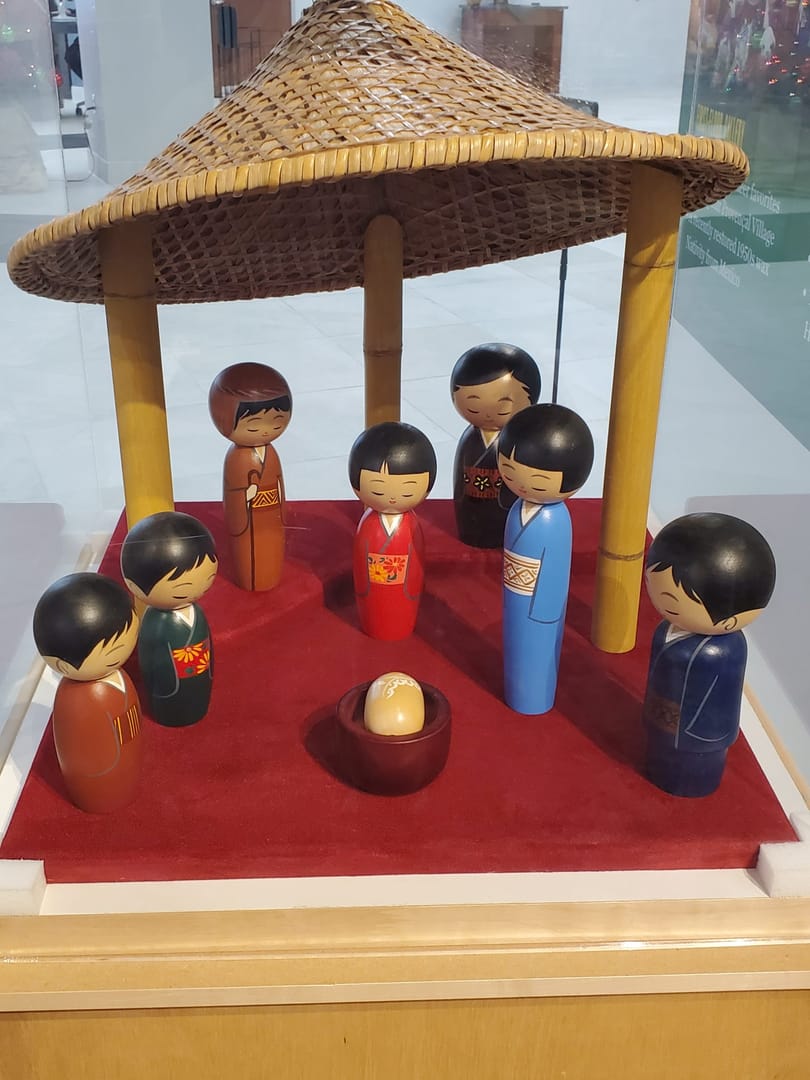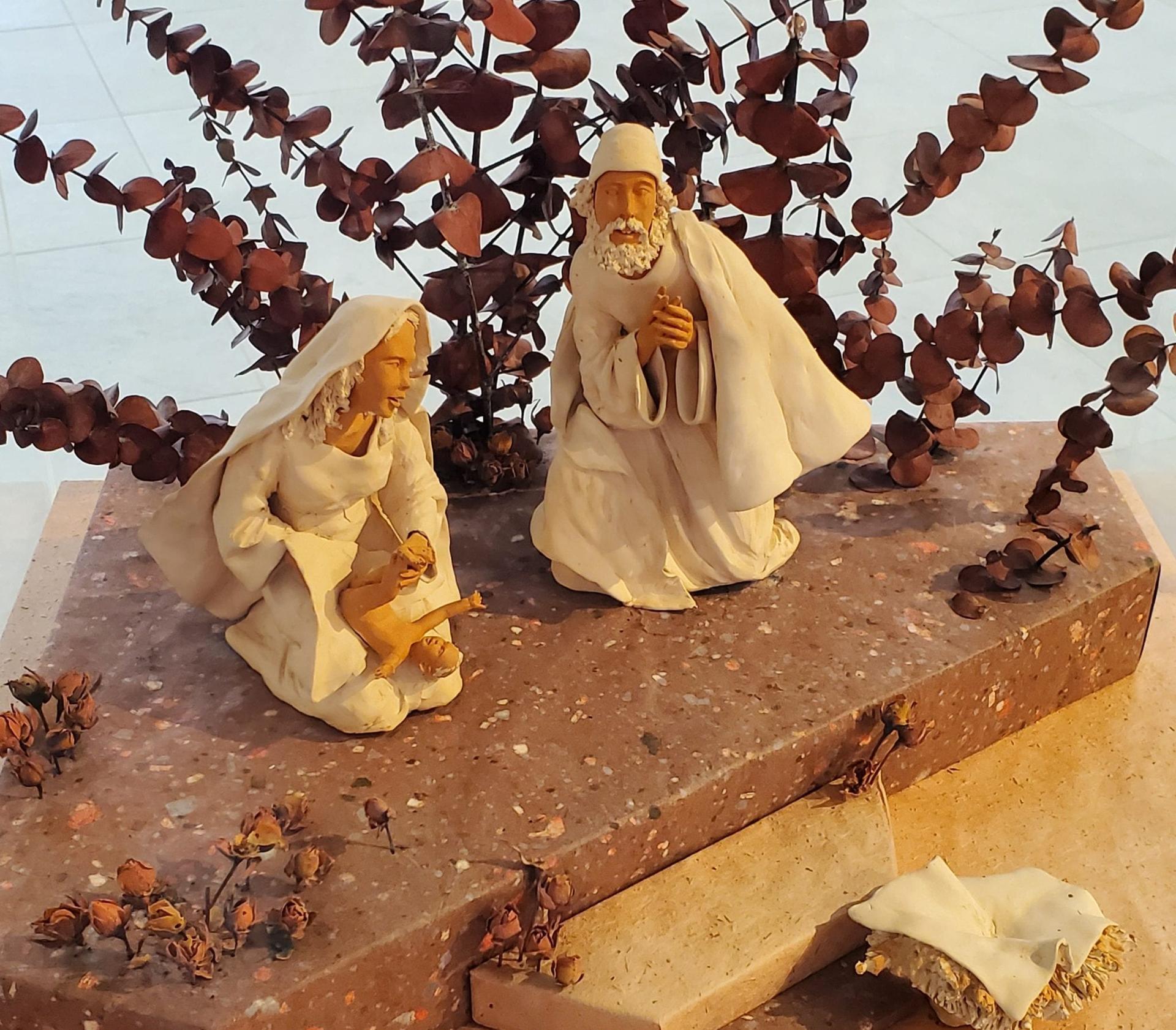DAYTON, Ohio – Hand-crafted nativity scenes ranging from “The Accident,” a playful depiction of Mary changing Jesus’ diaper, to “The Devil Never Far,” a jarring commentary on Satan’s view of Jesus’ birth, have attracted 3,500 visitors to Dayton’s Marian Library this December.
Curated from a collection of 3,700 nativity sets – also known as crèches – from more than 100 countries, the annual “At the Manger” exhibit has been providing free, public access since 1995 to some of the world’s most creative renderings of the birth of Christ.

“They’re such a wonderful kind of entryway into the story of the Incarnation,” explained Sarah Burke Cahalan, Director of the Marian Library at the University of Dayton. “There’s often a sense of humor to them and an accessibility there that makes them a powerful tool for welcoming people within the Christian tradition.”
That undercurrent of humor is certainly on display in exhibits like “Hipster Nativity,” a scene featuring Magi on Segways, a drone, and the Holy Family posing for a selfie. A nearby nativity, “Like Wife, Like Husband,” is one of the rare crèches in which Joseph swaddles Jesus as Mary looks on supportively, rather than vice versa.
Those who aren’t quite ready to extend the Incarnation to hipsters and selfies often prefer the more solemn scenes of exhibits like “Kokeshi Dolls,” a peaceful Japanese wooden rendering, or “Washington National Cathedral Nativity,” a creche featuring an exquisite backdrop that took volunteer Harry Mushenheim more than 100 hours to construct.
Daily visitors to the exhibit are as diverse as the crèches themselves, running the full gamut from Catholic grade school class trips to senior living facility excursions. Many families in the region have incorporated an annual trip to the exhibit into their Christmas traditions.
In her interview with Crux, Cahalan highlighted the positive reception of the crèches among an unexpected group: college students. “The exhibit goes up around finals time, when a lot of them are stressed out and missing home, ready for Christmas,” she said.
“Visiting the crèches is sort of a way of easing their minds, reminding them that the whole chaos and stress of finals and papers is temporary and that they’re going home soon,” Cahalan continued. “We’ve seen quite a bit of that where students come in and you see the stress fall away a bit.”
Not all of these college students are Christians. Cahalan has noticed that many of Dayton’s non-Christian international students have found their way to the crèche exhibit over the years. For these students, Cahalan believes, the crèches seem to “make understanding their Christian neighbor a little bit easier.”
Creches in the Francis Era

Cahalan is not the only person to spotlight the role of crèches this Advent. On December 1, Pope Francis released an Apostolic Letter, Admirabile Signum, dedicated to the meaning and significance of nativity displays for Christians stretching back to the days of his namesake, St. Francis of Assisi.
The pope’s letter outlines the history of the crèche tradition beginning with a St. Francis-inspired live nativity, reflects on each of the key elements of the nativity scene, and connects the creche to the process of passing on the faith with joy.
Although his letter does not explicitly weigh in on “hipster nativities,” Francis does give a nod to what he calls the “fanciful additions” that make their way into nativity scenes around the world, writing that they “show that in the new world inaugurated by Jesus there is room for whatever is truly human and for all God’s creatures.”
Francis’s interest in the crèche tradition comes as little surprise to Cahalan, who sees it as consistent with his well-documented devotion to Mary and his openness to other types of popular devotion.
“He’s not a snobby pope,” she said with a laugh. “This is clearly a tradition that’s of the people, something that’s for the home, so I think it connects up with his general philosophy.”
“It also absolutely connects with his theology of solidarity with the marginalized,” added Cahalan. “For me, it makes sense that Pope Francis would have a respect for this tradition because it reminds people on an annual basis that Christ came in at the very margins of society.”
“A Labor of Love”
The Marian Library’s 2019 “At the Manger” exhibit was only possible because of more than 6,000 hours of volunteer work. The year’s theme, “A Labor of Love,” is a tribute to the work that those volunteers have put into the exhibit throughout its 25-year run.
These volunteers have come in many forms. For example, retiree Mary Jo Riegel gives group tours and helps out in a variety of capacities during the months leading up to the exhibit’s opening each year.
Riegel is also a founding member of the Friends of the Crèche organization, a group that connects nativity collectors around the country and supports the “At the Manger” initiative. Riegel’s personal nativity collection includes more than 300 crèches.
Harry Mushenheim, a retired math professor at the University of Dayton, has created more than 50 settings – background components such as stands, buildings, and landscapes – for nativity scenes during his years of voluntary involvement with the exhibit. The 2019 exhibit features a full room of Mushenheim settings.
Volunteers also make it possible for the Marian Library to keep track of its expansive collection as it loans nativities out each year. More than 300 crèches go out to various offices on the university’s campus, showing up in places like the RecPlex, the student athletic center.
The library also lends pieces from the collection to area parishes, national organizations, including the Knights of Columbus, and other universities, such as the University of Notre Dame.
Crux is dedicated to smart, wired and independent reporting on the Vatican and worldwide Catholic Church. That kind of reporting doesn’t come cheap, and we need your support. You can help Crux by giving a small amount monthly, or with a onetime gift. Please remember, Crux is a for-profit organization, so contributions are not tax-deductible.
















